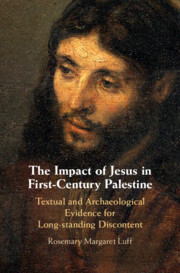 The Impact of Jesus in First-Century Palestine
The Impact of Jesus in First-Century Palestine Book contents
- The Impact of Jesus in First-Century Palestine
- The Impact of Jesus in First-Century Palestine
- Copyright page
- Dedication
- Contents
- Illustrations
- Preface
- Introduction
- Part I Memories of Jesus: The Textual Evidence
- 1 Discontent in Early First-Century Galilee and Judea
- 2 Jesus, the Temple, and the Chief Priests
- 3 The Character and Legacy of Jesus
- Part II Jesus in Context: The Archaeological Evidence
- Conclusion
- Bibliography
- Index
2 - Jesus, the Temple, and the Chief Priests
from Part I - Memories of Jesus: The Textual Evidence
Published online by Cambridge University Press: 26 July 2019
- The Impact of Jesus in First-Century Palestine
- The Impact of Jesus in First-Century Palestine
- Copyright page
- Dedication
- Contents
- Illustrations
- Preface
- Introduction
- Part I Memories of Jesus: The Textual Evidence
- 1 Discontent in Early First-Century Galilee and Judea
- 2 Jesus, the Temple, and the Chief Priests
- 3 The Character and Legacy of Jesus
- Part II Jesus in Context: The Archaeological Evidence
- Conclusion
- Bibliography
- Index
Summary
The purpose of this chapter is to utilise a more wide-ranging assessment of textual material, incorporating an approach from oral testimony, in order to understand the Evangelists’ understanding of Jesus’ attitude towards the Temple and its administration. The Gospels of Mark and John attest to the authenticity of the Temple incident, and also confirm that Jesus did speak openly about the destruction of the Temple. They also tally with reference to their Old Testament citations in that Jesus appears to be accusing the Temple authorities of corrupt behaviour. These New Testament texts have originated from oral versions that would have been in circulation much earlier than the written material, and therefore are strongly reminiscent of the words of Jesus. Jesus saw the Temple as a money-spinning enterprise operating at the expense of the poor, the intense commercialization obliterating any sense of a ‘house of prayer’. He viewed the rich landowners of the priesthood as a major cause of misery for the poor. Indeed his brother James carried on his ministry to the impoverished, and was remembered as vehemently denouncing the avarice and venality of the rich.
Keywords
- Type
- Chapter
- Information
- The Impact of Jesus in First-Century PalestineTextual and Archaeological Evidence for Long-standing Discontent, pp. 32 - 52Publisher: Cambridge University PressPrint publication year: 2019


